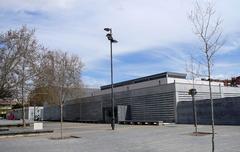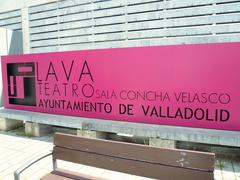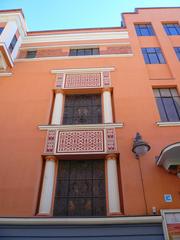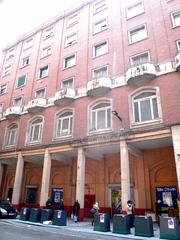
Valladolid Royal Palace Visiting Hours, Tickets, and Historical Guide
Date: 04/07/2025
Introduction
The Valladolid Royal Palace (Palacio Real de Valladolid) stands as a monumental testament to Spain’s royal heritage and Renaissance architectural mastery. Centrally located in Valladolid—a city that, for a brief period in the 17th century, was the capital of the Spanish Empire—the palace offers visitors a unique window into the political, artistic, and cultural currents that shaped early modern Spain. This guide provides a thorough exploration of the palace’s history, architecture, visiting details, and the surrounding attractions, giving travelers the tools to make the most of their visit to this historic landmark.
(Turismo Castilla y León; Spain.info)
Historical Overview
Origins and Construction
Commissioned in 1524 by Francisco de los Cobos, royal secretary to Emperor Charles V, the Valladolid Royal Palace was designed by Luis de Vega, one of the era’s leading architects. The original structure exemplified the Renaissance ideals of symmetry, proportion, and classical motifs, with a central courtyard that became the architectural heart of the palace. Its strategic location, close to the Iglesia de San Pablo and the family estate of María de Mendoza, reflected the influence and status of its patron.
(kids.kiddle.co)
Royal Expansion and Political Significance
Under Charles V and subsequent monarchs, the palace was expanded with additional courtyards, a chapel, and state rooms, transforming it into a suitable royal residence. Between 1601 and 1606, during Valladolid’s tenure as the Spanish capital under Philip III, the palace reached its peak as the seat of the royal court. It was here that key political events, royal births, and diplomatic ceremonies unfolded, reinforcing Valladolid’s central role in Spain’s Golden Age.
(kids.kiddle.co)
Architectural Evolution
After its Renaissance beginnings, the palace’s facade and internal spaces were progressively updated. The 17th-century introduction of the Herrerian style—distinguished by its symmetry and austere ornamentation—marked a significant transformation. The monumental staircase by Ventura Rodríguez, inspired by the Alcázar of Toledo, and Neo-Renaissance touches added in the 20th century, reflect the palace’s adaptive architectural journey.
(mycityhunt.com; spain.info)
Historical Roles and Residents
Throughout its history, the palace was the backdrop to pivotal moments, including Napoleon Bonaparte’s residence during the Peninsular War. It hosted monarchs such as Charles I, Philip III, and Isabella II, and witnessed the birth of Philip IV. Its subsequent transformation into a military headquarters in the 19th century marked a shift from royal residence to administrative hub, a role it continues in the present as the headquarters for the 4th General Sub-inspection of the Spanish Army.
(kids.kiddle.co; wikipedia.org)
Architectural Highlights
Renaissance and Herrerian Features
- Main Courtyard: Two-story galleries with elliptical arches, allegorical medallions, and coffered ceilings reflect the Renaissance style.
- Herrerian Facade: Symmetrical, austere, and monumental, with Palladian windows and imposing towers—an homage to Juan de Herrera’s architectural principles.
- Monumental Staircase: Designed by Ventura Rodríguez, this grand staircase is a focal point for visitors and an exemplar of late 18th-century design.
Interior and Decorative Art
- Chapel and Throne Room: Still visible on guided tours, these spaces showcase period religious art and intricate woodwork.
- Gallery of the Princes of Savoy: A secondary courtyard with semicircular arches and a central marble fountain, bridging Renaissance and Baroque influences.
- Ornate Ceilings and Furnishings: Coffered ceilings, original furnishings, and historic artifacts are preserved in select rooms.
Gardens
While not as expansive as other royal residences, the palace gardens provide a tranquil retreat, notable for their manicured lawns and ornamental plantings.
(evendo.com)
Visiting the Valladolid Royal Palace
Location
Plaza de la Universidad, 2, 47002 Valladolid, Spain—centrally located and within walking distance of the city’s main attractions.
(Scripture Savvy)
Visiting Hours
- Guided tours: Wednesdays at 12:00 PM (except holidays and during August, when the palace is closed).
- Exterior and courtyards: Accessible to the public at all hours from Plaza de San Pablo.
- Note: Hours may change for special events or official functions; always verify ahead of your visit. (Turismo Castilla y León)
Tickets and Reservations
- Entry: Free admission for guided tours.
- Booking: Advance telephone reservation required (+34 983 327 302).
- Languages: Tours are in Spanish; arrange a translator if needed.
- Photography: May be restricted inside; confirm with your guide. (Turismo Castilla y León)
Accessibility
While the palace’s exterior and courtyards are generally accessible, some interior spaces may pose challenges for visitors with mobility issues due to historic architecture. Contact the palace in advance for specific needs.
Visitor Tips
- Dress respectfully, as the palace remains an official building.
- Combine your visit with nearby landmarks like Iglesia de San Pablo, National Sculpture Museum, Plaza Mayor, and Casa de Cervantes.
- Plan for weather: Valladolid’s seasonal extremes make spring and autumn the best times to visit. (Spain.info; Adventure Backpack)
Nearby Attractions
- Iglesia de San Pablo: Noteworthy for its elaborate Gothic façade.
- National Museum of Sculpture: Houses one of Spain’s finest collections of religious sculpture.
- Plaza Mayor: The historic heart of Valladolid, surrounded by cafés and shops.
- Palacio de Pimentel: Birthplace of King Philip II and another Renaissance gem. (trek.zone; Spain.info)
Frequently Asked Questions (FAQ)
Q: What are the Valladolid Royal Palace visiting hours?
A: Guided tours are available Wednesdays at 12:00 PM, except holidays and August. Exterior and courtyards can be visited at any time.
Q: How do I reserve tickets?
A: Call +34 983 327 302 in advance to book your free spot on a guided tour.
Q: Is the palace wheelchair accessible?
A: The exterior and some areas are accessible, but the interior may be challenging due to historic architecture.
Q: Are guided tours available in English?
A: Tours are conducted in Spanish; arrange a translator if required.
Q: Can I take photos inside?
A: Interior photography may be restricted. Check with your guide.
Essential Contacts and Resources
- Tour Reservations: +34 983 327 302
- Tourism Office: Estación de Trenes Valladolid-Campo Grande or Punto de Información Turística de San Benito
- Official tourism websites:
Visuals and Maps
- Image: Valladolid Royal Palace exterior with Renaissance facade
- Image: Main courtyard with elliptical arches and medallions
- Map: Plaza de San Pablo, showing palace and surrounding landmarks
Final Recommendations
- Book your tour early—spots are limited and fill up quickly.
- Explore Valladolid’s culinary scene in nearby tapas bars.
- Pair your palace visit with the city’s renowned cultural events, like Semana Santa and SEMINCI.
- Use the Audiala app (if available) for audio tours and travel tips.
Summary
The Valladolid Royal Palace is a landmark that eloquently reflects Spain’s royal history and architectural development. Its blend of Renaissance, Herrerian, and Neo-Renaissance elements, combined with its pivotal political and cultural roles, make it a must-visit for anyone interested in Spanish heritage. While interior access is limited, guided tours offer a rare glimpse into the palace’s opulent past, and its central location makes it a convenient starting point for exploring Valladolid’s historical center.
(mycityhunt.com; Turismo Castilla y León; Spain.info; Explore in Spain)
Sources
- Turismo Castilla y León - Royal Palace
- Spain.info - Former Royal Palace Valladolid
- Explore in Spain - Valladolid: A Journey Through the Heart of Castilian History
- mycityhunt.com - Valladolid Royal Palace
- trek.zone - Palacio de Pimentel

























